If you find yourself waking up at the slightest noise or movement, you might be what's commonly known as a light sleeper. This sleep pattern, characterized by increased sensitivity to environmental disturbances during sleep, can significantly impact your rest quality and overall well-being. Understanding the nature of light sleep and implementing effective strategies can help you achieve more restorative rest.
While being a light sleeper isn't necessarily a sleep disorder, it can present unique challenges in achieving consistent, quality sleep. Let's explore what it means to be a light sleeper, its causes, and practical solutions for improving your sleep experience.
Understanding Light Sleep Patterns
Light sleeping is characterized by increased arousal during sleep, making individuals more responsive to external stimuli like noise, light, or movement. This heightened sensitivity often results in frequent wake-ups throughout the night, affecting sleep continuity and quality.
During normal sleep, we cycle through different sleep stages, including light and deep sleep. Light sleepers tend to spend more time in lighter sleep stages and may have difficulty maintaining deeper, more restorative sleep phases.
Common Causes of Light Sleeping
Genetic Factors
Research suggests that sleep sensitivity can be partially inherited, with some people naturally more prone to light sleeping due to their genetic makeup. This may influence how their brain processes and responds to environmental stimuli during sleep.
Environmental Influences
Various external factors can contribute to light sleeping patterns:
- Noise pollution
- Light exposure
- Temperature fluctuations
- Partner movement
- Irregular sleep schedules
Psychological Factors
Mental states and conditions can significantly impact sleep sensitivity:
- Anxiety and stress
- Racing thoughts
- Hypervigilance
- Past trauma or sleep-related anxiety
Strategies for Improving Sleep Quality
Create an Optimal Sleep Environment
Implementing these environmental modifications can help minimize sleep disruptions:
- Use blackout curtains or eye masks
- Maintain a cool room temperature
- Utilize white noise machines
- Invest in a comfortable mattress and pillows
- Consider separate blankets when sharing a bed
Establish a Consistent Sleep Routine
Developing regular sleep habits can help train your body for better rest:
- Set consistent bedtime and wake times
- Create a relaxing bedtime routine
- Limit screen time before bed
- Practice stress-reduction techniques
- Avoid caffeine and heavy meals close to bedtime
Consider Sleep Hygiene Practices
Maintaining good sleep hygiene can significantly improve sleep quality:
- Exercise regularly (but not too close to bedtime)
- Limit daytime napping
- Expose yourself to natural daylight
- Create a peaceful bedroom environment
- Manage stress through relaxation techniques
Frequently Asked Questions
What does it mean to be a light sleeper and how does it affect sleep quality?
Being a light sleeper means you're easily awakened by environmental stimuli during sleep. This can result in fragmented sleep patterns, reduced time in deep sleep stages, and potentially lower overall sleep quality, leading to daytime fatigue and decreased cognitive performance.
What are the common causes and factors that make someone a light sleeper?
Light sleeping can be attributed to various factors including genetics, environmental conditions, psychological state, lifestyle habits, and certain medical conditions. Stress, anxiety, and irregular sleep schedules can also contribute to increased sleep sensitivity.
How can light sleepers improve their ability to stay asleep and get deeper rest?
Light sleepers can improve their sleep by optimizing their sleep environment, maintaining consistent sleep schedules, practicing relaxation techniques, and addressing underlying stress or anxiety. Using white noise, blackout curtains, and comfortable bedding can also help minimize sleep disruptions.
What are the differences between light sleep and deep sleep stages?
Light sleep is characterized by easier arousal and more brain activity, while deep sleep features slower brain waves, reduced responsiveness to external stimuli, and more restorative processes. Deep sleep is crucial for physical recovery and memory consolidation.
Can being a light sleeper impact overall health and daytime functioning?
Yes, being a light sleeper can affect daily functioning through decreased energy levels, reduced concentration, mood changes, and impaired cognitive performance. However, with proper sleep strategies and environmental modifications, many light sleepers can achieve better quality rest and improved daytime functioning.




